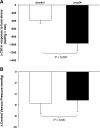Heat-stress-induced changes in central venous pressure do not explain interindividual differences in orthostatic tolerance during heat stress
- PMID: 21415173
- PMCID: PMC3098660
- DOI: 10.1152/japplphysiol.00035.2011
Heat-stress-induced changes in central venous pressure do not explain interindividual differences in orthostatic tolerance during heat stress
Abstract
The extent to which heat stress compromises blood pressure control is variable among individuals, with some individuals becoming very intolerant to a hypotensive challenge, such as lower body negative pressure (LBNP) while heat stressed, while others are relatively tolerant. Heat stress itself reduces indexes of ventricular filling pressure, including central venous pressure, which may be reflective of reductions in tolerance in this thermal condition. This study tested the hypothesis that the magnitude of the reduction in central venous pressure in response to heat stress alone is related to the subsequent decrement in LBNP tolerance. In 19 subjects, central hypovolemia was imposed via LBNP to presyncope in both normothermic and heat-stress conditions. Tolerance to LBNP was quantified using a cumulative stress index (CSI), and the difference between normothermic CSI and heat-stress CSI was calculated for each individual. The eight individuals with the greatest CSI difference between normothermic and heat-stress tolerances (LargeDif), and the eight individuals with the smallest CSI difference (SmallDif), were grouped together. By design, the difference in CSI between thermal conditions was greater in the LargeDif group (969 vs. 382 mmHg × min; P < 0.001). Despite this profound difference in the effect of heat stress in decreasing LBNP tolerance between groups, coupled with no difference in the rise in core body temperatures to the heat stress (LargeDif, 1.4 ± 0.1°C vs. SmallDif, 1.4 ± 0.1°C; interaction P = 0.89), the reduction in central venous pressure during heat stress alone was similar between groups (LargeDif: 5.7 ± 1.9 mmHg vs. SmallDif: 5.2 ± 2.0 mmHg; interaction P = 0.85). Contrary to the proposed hypothesis, differences in blood pressure control during LBNP are not related to differences in the magnitude of the heat-stress-induced reductions in central venous pressure.
Figures


References
-
- Allan JR, Crossley RJ. Effect of controlled elevation of body temperature on human tolerance to +Gz acceleration. J Appl Physiol 33: 418–420, 1972. - PubMed
-
- Bungo MW, Charles JB, Johnson PC. Cardiovascular deconditioning during space flight and the use of saline as a countermeasure to orthostatic intolerance. Aviat Space Environ Med 56: 985–990, 1985. - PubMed
-
- Cai Y, Holm S, Jenstrup M, Stromstad M, Eigtved A, Warberg J, Hojgaard L, Friberg L, Secher NH. Electrical admittance for filling of the heart during lower body negative pressure in humans. J Appl Physiol 89: 1569–1576, 2000. - PubMed
Publication types
MeSH terms
Grants and funding
LinkOut - more resources
Full Text Sources

